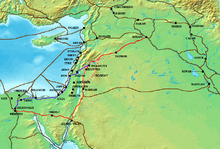
Back طريق البحر Arabic Via Maris Byelorussian Виа Марис Bulgarian ভায়া মারিস Bengali/Bangla Via Maris Catalan Via Maris Czech Via Maris CV Via Maris German Via Maris DIQ Vía Maris Spanish
This article needs additional citations for verification. (November 2013) |


Via Maris is one modern name for an ancient trade route, dating from the early Bronze Age, linking Egypt with the northern empires of Syria, Anatolia and Mesopotamia — along the Mediterranean coast of modern-day Egypt, Israel, Turkey and Syria. In Latin, Via Maris means "way of the sea", a translation of the Greek ὁδὸν θαλάσσης found in Isaiah 9:1 of the Septuagint, itself a translation of the Hebrew דֶּ֤רֶךְ הַיָּם֙ . It is a historic road that runs in part along the Palestinian Mediterranean coast. It was the most important route from Egypt to Syria (the Fertile Crescent) which followed the coastal plain before crossing over into the plain of Jezreel and the Jordan valley.
One earlier name was "Way of the Philistines", a reference to a passageway through the Philistine Plain (which today consists of Israel's southern coastal plain and the Gaza Strip). Academic researchers prefer other names, for instance "International Trunk Road"[1] or "International Coastal Highway" (also uncapitalised).[2]
Together with the King's Highway, the Via Maris was one of the major trade routes connecting Egypt and the Levant with Anatolia and Mesopotamia. The Via Maris was crossed by other trading routes, so that one could travel from Africa to Europe or from Asia to Africa. It began in al-Qantara and went east to Pelusium, following the northern coast of Sinai through el-Arish and Rafah. From there it followed the coast of Canaan through Gaza, Ascalon, Isdud, Aphek avoiding the Yarkon River, and Dor before turning east again through Megiddo and the Jezreel Valley until it reached Tiberias on the Sea of Galilee. Again turning northward along the lake shore, the Via Maris passed through Migdal, Capernaum, and Hazor. From Hazor it crossed the northern River Jordan at what later became known as Jacob's Ford, then climbed sharply over the Golan Heights and wound its way northeast into Damascus. Here travellers could continue on the King's Highway as far as the Euphrates River or proceed northward into Anatolia.
© MMXXIII Rich X Search. We shall prevail. All rights reserved. Rich X Search